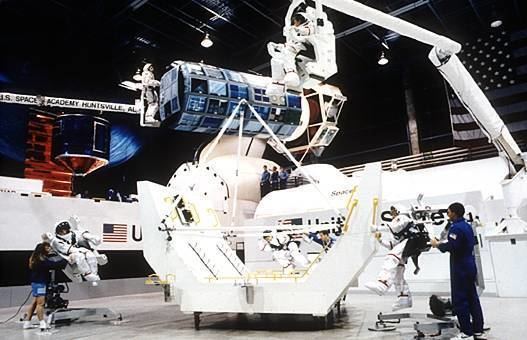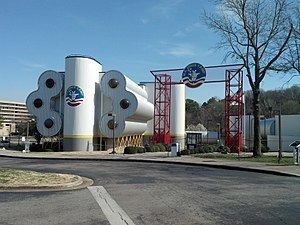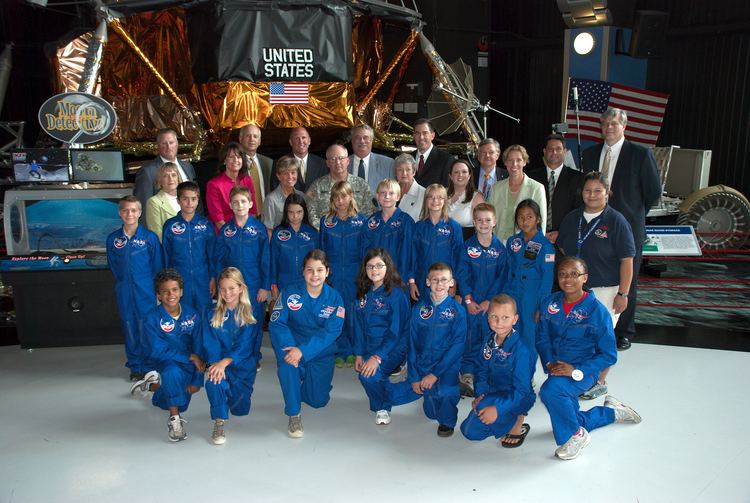Opening date 1982 (1982) | ||
 | ||
Location Huntsville, Alabama, U.S. Management U.S. Space & Rocket Center Similar US Space & Rocket Center, Huntsville Botanical Garden, Monte Sano State Park, Big Spring Park, Huntsville Museum of Art | ||
U.S. Space Camp is a camp and related programs owned and operated by the Alabama Space Science Exhibit Commission's U.S. Space & Rocket Center in Huntsville, Alabama. The camp provides residential and day camp educational programs for children and adults. These programs include space oriented camp programs, aircraft themed Aviation Challenge camps, and robotics themed programs, which are designed to promote science, engineering, aviation and technology.
Contents
- History
- US Space Rocket Center Foundation
- Space Camp Florida
- Space Camp California
- Space Camp Hall of Fame
- Programs
- Scholarships
- SCI VIS
- Deaf Space Camp
- Other programs
- Aviation Challenge
- Simulators
- Accommodations
- Movies and TV
- Notable attendees and guests
- References

History

Space Camp was founded in 1982 as an educational camp program for children using the United States space program as the basis to promote math and science to children. The idea for the camp came about as a result of a discussion between Wernher von Braun and Edward O. Buckbee. von Braun was touring the U.S. Space & Rocket Center with Buckbee in 1977 when he noticed children studying rockets and making notes. According to Buckbee, von Braun commented, "You know, we have all these camps for youngsters in this country - band camps and cheerleader camps and football camps. Why don't we have a science camp?"

Summer 2007 was the 25th Anniversary of Space Camp and the related programs. The 500,000th camper, Samantha Rice, graduated June 15, 2007. The U.S. Space & Rocket Center added to the museum the Space Camp Hall of Fame, in which the first inductee was Wernher von Braun.
U.S. Space & Rocket Center Foundation

The U.S. Space & Rocket Center and Space Camp (formerly U.S. Space Camp) in Huntsville are operated by the Alabama Space Science Exhibit Commission, which is a state agency whose members are appointed by the Governor of Alabama.
The non-profit U.S. Space & Rocket Center Foundation is a separate entity and members of its board are not appointed by the governor. It is responsible for scholarship fund-raising and the licensing of camps outside the United States. There are a number of internationally licensed Space Camps, including Space Camp Turkey, Space Camp Canada (known as "Camp Spatial" in French), and Space Camp Belgium. In 2011 the U.S. Space & Rocket Center Foundation planned to license additional camps in Singapore, the United Arab Emirates, India, and Malaysia.
Space Camp Florida
Space Camp Florida opened in 1988 and shared facilities with the Astronaut Hall of Fame in Titusville, Florida, both of which were operated by the now defunct U.S. Space Camp Foundation. The Space Camp facility closed in 2002, due to low attendance leading to financial difficulties. About 50,000 children attended the camp during its run, but in its final year as few as 14 participants filled 276 slots. The Astronaut Hall of Fame was sold to Delaware North and currently remains open as added attraction to the Kennedy Space Center Visitor Complex with several simulators previously used by the camp now available to all visitors.
Space Camp California
Space Camp California, operated by the now defunct U.S. Space Camp Foundation was located at Mountain View, California and opened in 1996. Space Camp California closed its doors January 6, 2002, also due to financial difficulties.
Space Camp Hall of Fame
The Space Camp Hall of Fame began in 2007 during the 25th anniversary celebrations. According to the website, the hall was "designed to honor graduates, former employees and supporters who have distinguished themselves in their respective careers or made considerable in-kind contributions in an effort to help further the goals of the Space Camp program."
Programs
Program names are used to define the age or focus group for which the specific program targets, with Space Camp referring to both a camp program and the parent organization. The camp offers programs for various ages and durations of visit. The majority of attendees visit during the summer, though spring and fall often see many school group visits, parent and child bonding camps, and adult or corporate programs.
Space Camp is offered for children between 9 and 11 years old, and typically runs from three to six days. The curriculum is designed to balance education and entertainment. Children enrolling in Space Camp can choose from one of three "tracks" of activities and study: space, aviation and robotics. Space Camp was the first of the camp programs offered, and is used as the umbrella organization name. More than 500,000 people have attended week-long programs.
Space Academy is a program intended for ages 12–14, offered in six-day sessions.
Advanced Space Academy is designed for 15- to 18-year-olds. The program was originally known as Space Academy Level II and was started in Fall of 1987. In 1987 the Space Academy Level II program was college accredited (1 hour) through the University of Alabama Huntsville. It also offered programs for adults as the first class to go through Level II were adults. The Parent/Child Space Camp program allows parents or guardians to attend Space Camp with their child aged 7–12 years. The program is run throughout the year, lasts three to four days, and includes activities in which the adult and child work together. Parent/Child also has an Aviation Challenge option, designed for children and their accompanying adult, offered during the summer months.
Scholarships
Space Camp offers scholarships for kids with disabilities, academic greatness, excellence in leadership, and financial needs or disadvantaged.
SCI-VIS
In cooperation with teachers of visually impaired students, Space Camp operates a week-long Space Camp for Interested Visually Impaired Students by providing the same experience to visually impaired students as sighted students. Adaptations are made to the computer systems campers use in activities and simulations to provide speech and large print output. Adapted materials, including handbooks translated in Braille, and equipment are used during the camp.
Deaf Space Camp
In cooperation with teachers, Space Camp operates a week-long program for Deaf and hard of hearing students by providing the same experience to hearing impaired students as hearing students. Communication is supported by a dedicated team of American Sign Language interpreters as well as through visual and written media. To allow equal access to the audio of films, most museum & camp movies have open or closed captions; the theater provides a rear-window captioning system. To augment or replace microphone/headset technology, students use live stream video between mission control and the shuttle simulator.
In addition to participating in typical camp activities and simulations, students often have the opportunity to meet and interact with deaf adults who work in science-related fields and learn about the many contributions deaf individuals such as Annie Jump Cannon (astronomer), Tsiolkovsky (considered of a "father of Rocketry"), and Dr. Thomas Wheeler (deaf NASA aerospace engineer) have made to astronomy, space exploration and science education.
Other programs
Other programs include corporate programs, programs for adults and educators and educational field-trip programs for school groups, and the X-Camp outdoor leadership camp. There were also special alumni sessions during the summer of the 25th Anniversary.
Occasionally themed camps have been offered, usually in conjunction with museum exhibits. During the summer of 2010 a Jedi Experience camp was offered in connection with the museum traveling exhibit Star Wars: Where Science Meets Imagination.
Aviation Challenge
Aviation Challenge, or AC, is an umbrella branding for a set of aviation oriented camps at Space Camp, consisting of three main programs for children from ages 9–18. As an aviation oriented camp the fundamental teaching aids are computer based flight simulators, which are intended to train attendees to fly, act, and think like United States Air Force, Navy or Marine fighter pilots.
Simulators
There are simulators at Space Camp, such as:
Space Camp additionally uses rides or attractions that are on site at the U.S. Space and Rocket Center as instructional tools. While these are not true simulators, the use of these rides is designed to allow the rider to better understand some aspect of space travel. The Space Shot simulates liftoff, and the G-Force Accelerator simulates the G-forces put on astronauts while re-entering the Earth's atmosphere or during launch.
The Spacedome IMAX Theater provides a venue for presenting some of the space and science oriented films produced through the IMAX camera/projection system. The theater is part of the U.S. Space and Rocket Center museum complex. As Space Camp is operated by the U.S. Space and Rocket Center, it makes regular use of the theater.
Accommodations
If a Space Camp program takes more than one day, "campers" stay at the space camp's Habitat 1 or Habitat 2. Habitat 1 is a large building designed to house young people. It is manned by staff and has full CCTV. Male and female campers are usually assigned to separate floors.
Aviation Challenge trainees stay in Habitat 3 where they are required to maintain military standards to their bays and racks. There are two floors to Hab 3. Males live on half of the ground floor and all of the second floor. Female trainees stay on the other half of the first floor. The bays are named after famous aircraft carriers. The camp has a cafeteria where campers receive meals.
